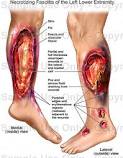 In the media today are reports of a 24 year old woman, Aimee Copeland, who is currently in the hospital in critical condition as a result of an infection of a flesh eating bacteria. Copeland had her leg amputated and could lose more limbs as the infection, which entered from a cut on her calf, spreads.
In the media today are reports of a 24 year old woman, Aimee Copeland, who is currently in the hospital in critical condition as a result of an infection of a flesh eating bacteria. Copeland had her leg amputated and could lose more limbs as the infection, which entered from a cut on her calf, spreads.
Many are now asking questions like, “What is flesh eating bacteria, and what are the warning signs that an infection could be linked to flesh eating bacteria?”
First, to ease any potential panic, cases of flesh eating bacteria (necrotizing fasciitis) are relatively rare. According to the Centers for Disease Control and Prevention (CDC), flesh eating bacteria is a variant of Group A Streptococcus (GAS). The same virus responsible for what is commonly called “strep throat,” a very common illness.
The CDC says that the Streptococcus bacteria is very common on the skin or in the throat with no signs of illness. It is when the bacteria enter into the parts of the body where bacteria usually are not found, such as the blood, muscle, or the lungs that it becomes the life threatening illness of necrotizing fasciitis, commonly called “flesh eating bacteria.”
From the CDC web site, “These infections are termed ‘invasive GAS disease.’ Two of the most severe, but least common, forms of invasive GAS disease are necrotizing fasciitis and streptococcal toxic shock syndrome. Necrotizing fasciitis (occasionally described by the media as “the flesh-eating bacteria”) is a rapidly progressive disease which destroys muscles, fat, and skin tissue.” As many as 25% of individuals with flesh eating bacteria die as a result.
Like most bacteria, GAS is spread through contact with mucus or skin infections. The real danger for flesh eating bacteria is when it enters the body through a cut or opening in the flesh. To prevent potential loss of limbs or death, such infections must be treated early and aggressively.
Warning Signs
The early warning signs to look for related to necrotizing fasciitis or flesh eating bacteria according to the CDC are: Severe pain and swelling, often rapidly increasing, Fever, and Redness at a wound site. Seek immediate medical attention for such symptoms especially if the pain related to a cut or wound is abnormally high and/or the pain is felt in the body farther away from the injury site than normal.
Treatment
Treatment for flesh eating bacteria includes very high doses of penicillin and clindamycin. Tips for help avoid getting or spreading the flesh eating bacteria include, good hand washing, especially after coughing and sneezing and before preparing foods or eating. Individuals diagnosed with strep throat should stay home from work, school, or day care until 24 hours after taking an antibiotic.
Finally, the CDC says that, “All wounds should be kept clean and watched for possible signs of infection such as redness, swelling, drainage, and pain at the wound site. A person with signs of an infected wound, especially if fever occurs, should immediately seek medical care.”
![Herbal Reference Substances are Key to Everyday Products <!-- AddThis Sharing Buttons above -->
<div class="addthis_toolbox addthis_default_style " addthis:url='http://newstaar.com/herbal-reference-substances-are-key-to-everyday-products/3512112/' >
<a class="addthis_button_facebook_like" fb:like:layout="button_count"></a>
<a class="addthis_button_tweet"></a>
<a class="addthis_button_pinterest_pinit"></a>
<a class="addthis_counter addthis_pill_style"></a>
</div>When it comes to quality control testing and the development of new products, Botanical Reference Materials (BRMs), also known as Herbal References are critically important. To help companies ultimately obtain all-important FDA approval, the Food and Drug Administration provides in its guidance a recommendation that […]<!-- AddThis Sharing Buttons below -->
<div class="addthis_toolbox addthis_default_style addthis_32x32_style" addthis:url='http://newstaar.com/herbal-reference-substances-are-key-to-everyday-products/3512112/' >
<a class="addthis_button_preferred_1"></a>
<a class="addthis_button_preferred_2"></a>
<a class="addthis_button_preferred_3"></a>
<a class="addthis_button_preferred_4"></a>
<a class="addthis_button_compact"></a>
<a class="addthis_counter addthis_bubble_style"></a>
</div>](http://newstaar.com/wp-content/uploads/2021/02/Achillea_millefolium_flowers-100x100.jpg)
![Quality Electrochemical Biosensors are Critical for Medical, Food and Chemical Industry <!-- AddThis Sharing Buttons above -->
<div class="addthis_toolbox addthis_default_style " addthis:url='http://newstaar.com/quality-electrochemical-biosensors-are-critical-for-medical-food-and-chemical-industry/3512086/' >
<a class="addthis_button_facebook_like" fb:like:layout="button_count"></a>
<a class="addthis_button_tweet"></a>
<a class="addthis_button_pinterest_pinit"></a>
<a class="addthis_counter addthis_pill_style"></a>
</div>A number of industries have, at their core, a need to frequent or even continuous analysis of biological media. These include the medical and pharmaceutical fields, biotech firms, and food and chemical companies. To maintain quality standards and develop new products, these industries rely heavily […]<!-- AddThis Sharing Buttons below -->
<div class="addthis_toolbox addthis_default_style addthis_32x32_style" addthis:url='http://newstaar.com/quality-electrochemical-biosensors-are-critical-for-medical-food-and-chemical-industry/3512086/' >
<a class="addthis_button_preferred_1"></a>
<a class="addthis_button_preferred_2"></a>
<a class="addthis_button_preferred_3"></a>
<a class="addthis_button_preferred_4"></a>
<a class="addthis_button_compact"></a>
<a class="addthis_counter addthis_bubble_style"></a>
</div>](http://newstaar.com/wp-content/uploads/2020/10/Electrochemical-Biosensor-100x100.jpg)
![Company Develops Industrial Mixers Well-Suited for both Fragile and Explosive Products <!-- AddThis Sharing Buttons above -->
<div class="addthis_toolbox addthis_default_style " addthis:url='http://newstaar.com/company-develops-industrial-mixers-well-suited-for-both-fragile-and-explosive-products/3512071/' >
<a class="addthis_button_facebook_like" fb:like:layout="button_count"></a>
<a class="addthis_button_tweet"></a>
<a class="addthis_button_pinterest_pinit"></a>
<a class="addthis_counter addthis_pill_style"></a>
</div>Industrial drum mixers are normally applied to blend mixes of varying viscosities such as adhesive slurries or cement. Some of these mixers have the capability of blending mixes of very different particle sizes such as fruit and ice cream, and gravel and cement slurry. The […]<!-- AddThis Sharing Buttons below -->
<div class="addthis_toolbox addthis_default_style addthis_32x32_style" addthis:url='http://newstaar.com/company-develops-industrial-mixers-well-suited-for-both-fragile-and-explosive-products/3512071/' >
<a class="addthis_button_preferred_1"></a>
<a class="addthis_button_preferred_2"></a>
<a class="addthis_button_preferred_3"></a>
<a class="addthis_button_preferred_4"></a>
<a class="addthis_button_compact"></a>
<a class="addthis_counter addthis_bubble_style"></a>
</div>](http://newstaar.com/wp-content/uploads/2020/06/bandeau-sofragir2-100x100.jpg)